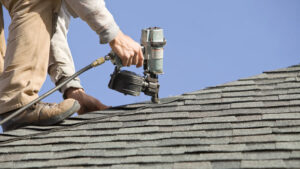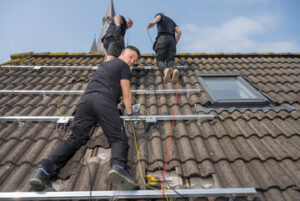Your roof is the barrier between your home and the elements. It’s important to keep up with roofing maintenance to protect your family from obvious dangers like falling limbs and less-obvious issues like excess moisture which can cause mold.

A roof inspection should be done on a routine basis and preferably before a storm hits. A trained roofing professional will look for workmanship problems that could lead to leaks.
Shingles are a vital part of your roof, protecting it from the elements. They also add to your home’s curb appeal and resale value. That’s why it’s so important to regularly inspect your shingle roof and repair any damage promptly.
The first sign of shingle damage is the loss of granules. These small black bits of material are what protect your roof from UV rays and give it stability. When granules are lost, your roof is exposed to the elements and is more at risk for water damage and deterioration.
Loose shingles are another common sign of shingle damage. If left unaddressed, a loose shingle can allow moisture into your home and lead to rot or mold growth. You can check for a loose shingle by climbing onto your roof and looking for the white guide strip on the underside of the shingle. If the strip is missing, it’s probably time to replace your shingle.
A damaged shingle can be easily fixed by using a flat pry bar and gently lifting the layer of shingles above it. Then, remove the nails holding the shingle in place with a claw or hammer. After removing the nail, slide the damaged shingle free and put in a new one. When you’re done, use a dab of sealant on the shingle base and over the nail holes to reinforce the area and keep water out of your home.
You can often camouflage a shingle repair by using matching shingle color to mask the patchwork effect. A roofing contractor can help you choose the right shingle color to match your existing shingles.
If your shingles are damaged by severe weather conditions, it’s best to schedule a repair as soon as possible to minimize the potential for leaks and other damage. If you’re concerned about the condition of your shingle roof, contact a local roofing company for an inspection and repair estimate.
The flashings and seals that connect your shingle roof to vents, skylights and chimneys are just as important as the shingles themselves. These areas are vulnerable to leaks, and if they’re not properly maintained by a professional roofing company, it can lead to expensive roof repairs down the road.
Flashings
Flashing is thin material that professional roofers install to prevent water from entering areas where it shouldn’t. These include gaps between a wall and the roof and around chimneys, skylights and other roof protrusions. Without flashings, these areas would be prone to moisture intrusion that could lead to puddles in the living room and even mold growth.
While it’s possible to patch small holes in these areas with additional sealant applications, larger gaps will need entirely new sections of flashings to ensure the area remains water tight. It’s important to keep an eye out for warning signs that the flashing is starting to fail, including discoloration on walls near where the flashing was installed due to trapped moisture and a general loss of waterproofing.
Generally, flashings are made of aluminum, galvanized steel, tin-coated metal or copper. Each type has its advantages and disadvantages in terms of durability and longevity. While the most durable materials tend to be more expensive, most builders prefer aluminum because it is budget-friendly and has a long lifespan.
Flashings protect vulnerable points on a roof that can’t be covered by shingles, such as the areas where a roof meets a wall or the low spots or valleys where two different slopes meet. Without flashings, heavy rain or wind-blown debris would blow right into these areas and cause serious damage.
Most professional roofers use a form of flashing called step or cap flashing to protect these areas. This is a strip of metal that extends downhill from the roof to the wall, forming a seal along the gap. The top of the flashing is secured to the wall with masonry screws and then coated with mastic.
The bottom of the flashing has a central opening for a pipe or vent. This opening is either made of the same material as the flashing (metal for a vent, for example) or a rubber compression fitting that wraps around a PVC pipe. The top of the flashing is then capped with a piece of metal, which is called counter flashing. This is installed as a single continuous strip. It is crucial that the flashing be lapped correctly, with each section being overlapped by at least 7 cm.
Gutters
Gutters play a significant role in protecting the integrity of your roof. They are instrumental in directing rainwater away from the structure, preventing water damage to your roof and foundation, preserving landscaping features, and safeguarding the fascia and soffit. Regular gutter cleaning and inspections can help ensure that your gutter system works properly, averting costly repairs in the future.
Gutter systems typically consist of a continuous channel that connects to the eaves, collecting the rainwater that falls off your roof and redirecting it away from the building through downspouts. The channel is lined with a durable material such as aluminum, galvanized steel, copper, zinc, or vinyl.
Clogged gutters can cause a host of problems, including water damage to the roof and walls of the building and to the basement. It can also lead to mold and mildew and contribute to health issues for building occupants. Gutters that are not regularly cleaned and inspected can result in the collection of leaves, twigs, and dirt, which leads to overflowing or backing up of water.
Failing to keep up with proper gutter maintenance can also nullify your roof warranty, so it is important to work with a roofing contractor that is experienced and certified to work on gutters. Gutters can be made of a variety of materials, including copper, aluminum, styrene butadiene (ABS), uPVC, cast iron, and galvanized steel.
Keeping up with the maintenance of your gutters, soffits, and fascia is essential to preserving the structural integrity of your roof. When these features become damaged, they can allow water to flow over the edge of your roof and saturate the fascia or soffit. This can damage the wood and cause rot, leading to costly repair and replacement. Gutters prevent this by guiding water runoff away from the home, preserving these elements and preventing costly repairs.
Another benefit of properly maintained gutters is that they can protect the foundation of your home and prevent soil erosion around the foundation. Without gutters, the water that runs off your roof can pool in areas near the foundation of your home, causing damage to the soil and saturating plants and landscaping. Gutters move the water away from these areas, preventing erosion and flood damage to your foundation.
Ventilation
Proper ventilation plays a critical role in the function of your roof. It helps regulate your attic’s temperature and moisture levels, reducing the likelihood of issues like ice dams, mold growth, and wood rot. It also helps reduce energy bills by lowering the amount of heat that is drawn from your house into the attic during summer.
Incorrect venting or poor ventilation are one of the most common causes of roofing problems. When these problems go unchecked, they can lead to leaks and other significant damage. Fortunately, there are certain signs that indicate that you have a problem with your roof’s ventilation system.
Water damage to the ceiling and interior walls is a clear indicator of a ventilation issue. This occurs because without proper airflow, the shingles and other roofing materials become overheated. This leads to deterioration and the formation of cracks, dents, and blisters. It can even cause rust on roofing nails and mold, mildew, and algae growth inside the home.
An improperly functioning ventilation system can also lead to a wet attic, which can be a serious problem for your attic and any stored items. Moisture in the attic can cause wood to rot, and it also provides a perfect environment for pests like mice, raccoons, squirrels, and termites. This can be a major problem, especially if you are planning to sell your home.
If your home or building has a poor ventilation system, it’s important to have a qualified roofer examine it and address any issues that may arise. This is especially true if you’re considering a reroofing project, as this would be the ideal opportunity to make sure your roof is properly ventilated.
There are a variety of different types of roof vents available, including ridge and soffit vents. Soffit vents are installed in the soffit area under the eaves, and they allow cool air to enter the attic while pushing out hot air from the ridge. Ridge vents are usually installed along the peak of the roof, and they help to keep snow from accumulating on the roof during winter.



